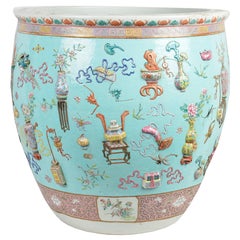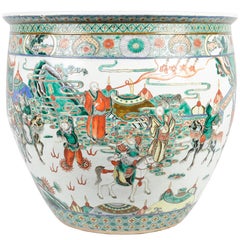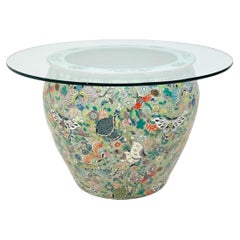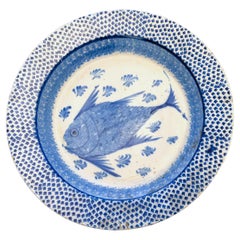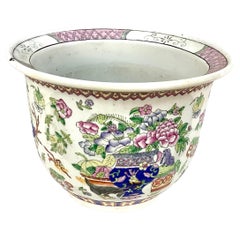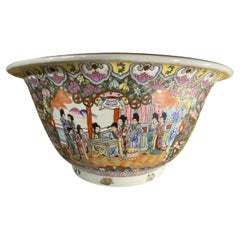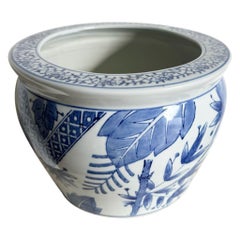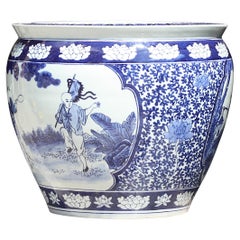Chinese Fish Porcelain
Antique Early 19th Century Chinese Chinese Export Porcelain
Porcelain
Antique 19th Century Chinese Porcelain
Porcelain
Antique Late 19th Century Chinese Other Ceramics
Porcelain, Paint
Antique Early 19th Century Chinese Chinese Export Platters and Serveware
Porcelain
Early 20th Century Chinese Qing Ceramics
Porcelain
20th Century Chinoiserie Planters, Cachepots and Jardinières
Porcelain
Vintage 1980s Chinese Vases
Porcelain
20th Century Decorative Bowls
Porcelain
Antique 19th Century Chinese Qing Serving Pieces
Porcelain
Early 20th Century Chinese Chinese Export Vases
Porcelain
20th Century Chinese Chinese Export Jars
Porcelain
Mid-20th Century Chinese Planters, Cachepots and Jardinières
Porcelain
Mid-20th Century Chinese Chinese Export Decorative Bowls
Porcelain
Antique 17th Century Chinese Ming Ceramics
Porcelain
Late 20th Century Chinese Planters and Jardinieres
Porcelain
Vintage 1960s Japanese Mid-Century Modern Serving Pieces
Porcelain
Antique 19th Century Chinese Chinese Export Ceramics
Porcelain
20th Century Chinese Chinese Export Jars
Porcelain
Early 20th Century East Asian Chinese Export Planters, Cachepots and Jar...
Porcelain
20th Century Chinese Chinoiserie Planters and Jardinieres
Porcelain, Paint
20th Century Chinese Chinese Export Vases
Porcelain
Antique Early 1900s Chinese Qing Ceramics
Porcelain
20th Century Chinese Chinese Export Table Lamps
Metal, Brass
20th Century Chinese Ming Vases
Porcelain
Late 20th Century Asian Planters and Jardinieres
Porcelain
Antique Early 19th Century Chinese Qing Ceramics
Porcelain
Antique 18th Century Chinese Other Ceramics
Porcelain
Late 20th Century Chinese Planters, Cachepots and Jardinières
Porcelain, Walnut
Late 20th Century Chinoiserie Dining Room Tables
Porcelain, Glass, Hardwood
Vintage 1980s Chinese Scholar's Objects
Porcelain
21st Century and Contemporary Chinese Chinese Chippendale Jars
Porcelain
21st Century and Contemporary Chinese Chinese Chippendale Jars
Porcelain
20th Century Chinese Chinese Export Centerpieces
Porcelain
Early 20th Century Chinese Chinese Export Planters, Cachepots and Jardin...
Porcelain
20th Century Chinese Chinese Export Vases
Porcelain, Celadon
20th Century Chinese Ceramics
Wire
20th Century Ceramics
Porcelain
Antique Early 19th Century Chinese Planters, Cachepots and Jardinières
Porcelain
Antique 17th Century Vietnamese Qing Antiquities
Ceramic, Porcelain
Antique 16th Century Chinese Ming Decorative Dishes and Vide-Poche
Porcelain
20th Century Chinese Table Lamps
Porcelain
Antique 19th Century Chinese Paintings and Screens
Porcelain
Antique 19th Century Chinese Vases
Porcelain, Giltwood
21st Century and Contemporary Chinese Vases
Porcelain
21st Century and Contemporary Chinese Chinese Export Vases
Porcelain
21st Century and Contemporary Chinese Jars
Porcelain
Antique 19th Century Chinese Planters, Cachepots and Jardinières
Porcelain
Late 20th Century Chinese Ming Planters, Cachepots and Jardinières
Porcelain
20th Century Chinese Serving Bowls
Porcelain
Mid-20th Century Chinese Chinoiserie Planters, Cachepots and Jardinières
Porcelain
Mid-20th Century Unknown Hollywood Regency Table Lamps
Porcelain
Antique 18th Century and Earlier Chinese Figurative Sculptures
20th Century Chinese Planters and Jardinieres
Porcelain
Antique 18th Century Chinese Ceramics
Porcelain
Antique 19th Century Chinese Ceramics
Porcelain
Antique 18th Century and Earlier Chinese Ceramics
Porcelain
Early 20th Century Chinese Animal Sculptures
Porcelain
Mid-20th Century Chinese Chinoiserie Planters, Cachepots and Jardinières
Porcelain
- 1
Chinese Fish Porcelain For Sale on 1stDibs
How Much is a Chinese Fish Porcelain?
- What is a Chinese fish bowl?1 Answer
 Lotus GalleryMarch 17, 2021A Chinese fish bowl is a large porcelain bowl, usually supported on a wooden stand. Oftentimes confused with planters or jardinieres, fish bowls will always have images of swimming fish or water plants to the interior of the bowl.
Lotus GalleryMarch 17, 2021A Chinese fish bowl is a large porcelain bowl, usually supported on a wooden stand. Oftentimes confused with planters or jardinieres, fish bowls will always have images of swimming fish or water plants to the interior of the bowl.  Lotus GallerySeptember 15, 2020
Lotus GallerySeptember 15, 2020Chinese porcelain can usually be dated by form and decoration. However, copies and forgeries abound, so you should have an expert such as an appraiser, reputable dealer or auction house, or museum examine your porcelain to accurately date it.
- 1stDibs ExpertApril 5, 2022A Chinese porcelain pillow is a type of ceramic object produced by Chinese artisans. They normally have highly decorative rectangular designs and feature curved tops. Historically, they functioned as headrests, but today they normally serve purely as decorations. On 1stDibs, shop a wide variety of Chinese porcelain ware.
- What is Chinese porcelain called?2 Answers
 PAGODA REDOctober 7, 2020
PAGODA REDOctober 7, 2020True porcelain ware was developed in the 11th century at the imperial kilns of Jingdezhen, Jiangxi province, China. These early porcelains of the Song and Yuan dynasties are known as Qingbai or Yingqing ware, defined by a light blue-grey glaze. Later forms of Chinese porcelain include blue and white underglaze ware, Celadon ware, Jun ware, Famille Verte ware, Wucai (Five Color) ware, and Dehua ware, also known as Blanc de Chine.
 Lotus GalleryMarch 17, 2021In China, porcelain is referred to a "cíqì" 瓷器.
Lotus GalleryMarch 17, 2021In China, porcelain is referred to a "cíqì" 瓷器. - 1stDibs ExpertApril 5, 2022Chinese Canton porcelain is a type of decorative hand-painted ceramic ware produced during the 18th, 19th and 20th centuries in China. Its name comes from the region where it originated. You will sometimes see it referred to as Cantonese porcelain. On 1stDibs, find a selection of Chinese Canton porcelain.
- 1stDibs ExpertApril 5, 2022In China, the Chinese koi fish usually represents wealth and success. Some folklore also equates the fish with love, marriage and fertility. Find a large collection of Chinese furniture, art and decorative objects from some of the world’s top sellers on 1stDibs.
 Lotus GallerySeptember 23, 2020
Lotus GallerySeptember 23, 2020The best way to know is to take it to an expert, such as an appraiser, reputable dealer or auction house, or museum
- 1stDibs ExpertAugust 20, 2024To identify Chinese porcelain marks, consult trusted online resources. Most markings on Chinese porcelain consist of four to six characters, and the last two often represent when a piece was produced. Since there is a lot of variation in the markings, looking at images shared on trustworthy websites is the best way to make an identification. Alternatively, you can use the services of a certified appraiser or knowledgeable antique dealer. On 1stDibs, explore a wide range of Chinese porcelain.
- 1stDibs ExpertApril 5, 2022To identify Chinese export porcelain, first look for a mark. Most pieces made after 1891 feature a maker's mark that you can research using authoritative online resources. Identifying older porcelain ware is more difficult. A licensed appraiser can provide assistance. You'll find a range of expertly vetted Chinese export porcelain on 1stDibs.
- 1stDibs ExpertApril 5, 2022You can sell old Chinese porcelain in a few ways. You can advertise the piece locally or work with an antique shop or auction house. There are also reputable online platforms available for selling online. Shop a collection of Chinese porcelain on 1stDibs.
- 1stDibs ExpertApril 5, 2022Chinese Kangxi porcelain was popular because of its particular blue colorings. The blue was made using cobalt ore which was imported from Persia. As cobalt ore was a scarce ingredient, the rarity made the porcelain items highly sought after. Shop a collection of Chinese Kangxi porcelain from some of the world’s top sellers on 1stDibs.
- 1stDibs ExpertApril 5, 2022Chinese blue and white porcelain is the most common type of decorated porcelain. Its name in Chinese is qinghua. On 1stDibs, you’ll find a collection of antique and modern Chinese blue and white porcelain from some of the world’s top sellers.
 PAGODA REDOctober 21, 2020
PAGODA REDOctober 21, 2020For thousands of years, China’s court-sponsored porcelain industry has been at the forefront of technical innovation and aesthetic refinement. Exquisite finishes and precision of form gave China an international reputation for fine ceramic wares. Age, shape, glaze, motif, and reign mark are all factors contributing to the value of a ceramic piece, indicative of the maker and the dynastic reign under which the object was created.
- 1stDibs ExpertMarch 22, 2022Chinese blue and white porcelain is called qinghua, pronounced “CHING-hwa.” Artisans first began producing the porcelain during the Tang and Song dynasties ranging from 609 to 1279. However, the techniques the pottery is most well known for weren't developed until the subsequent Ming era, which lasted until 1644. You'll find a collection of Chinese porcelain on 1stDibs.
